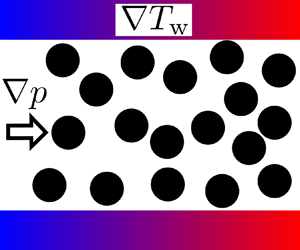Article contents
Poiseuille and thermal transpiration flows of a dense gas between two parallel plates
Published online by Cambridge University Press: 03 May 2023
Abstract

The Poiseuille and thermal transpiration flows of a dense gas between two parallel plates are investigated on the basis of the Enskog kinetic equation under the diffuse reflection boundary condition. In contrast to the case of an ideal gas, the density and the gradients of pressure and the normal stress component in the flow direction are not uniform in the direction normal to the plates for a dense gas. The non-uniform normal stress gradient contributes also to the acceleration or deceleration of the thermal transpiration flow for small Knudsen numbers. The profiles of mass and heat flows as well as the net mass flows are obtained for various Knudsen numbers and ratios of the molecular diameter to the distance of plates. In the analysis of the Poiseuille flow, most characteristics of a force-driven flow with a small force are recovered. However, for the case of a dense gas, differences between the force-driven and the present pressure-driven flows are observed even within the linearized regime for small force and pressure gradient, especially at the microscopic level. The behaviour of the velocity distribution functions, in particular, the way in which they approach the ones for the Boltzmann equation as the molecular diameter becomes smaller, is clarified.
Information
- Type
- JFM Papers
- Information
- Copyright
- © The Author(s), 2023. Published by Cambridge University Press
References
- 4
- Cited by


